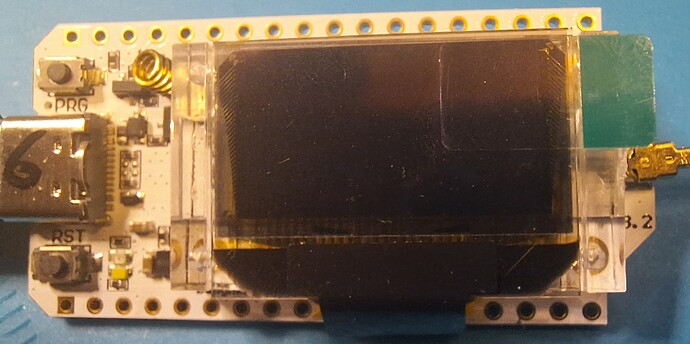Hi,
I don't know how to reply to two people at the same time, so this is in response to @srnet also.
Here is the code that I tried to compile. I essentially used the raw copy button from the example, so I don't know how it would have missed something, but for the sake of the argument, here is the code the way it is in my Arduino IDE:
/*******************************************************************************************************
Programs for Arduino - Copyright of the author Stuart Robinson - 17/12/19
This program is supplied as is, it is up to the user of the program to decide if the program is
suitable for the intended purpose and free from errors.
*******************************************************************************************************/
/*******************************************************************************************************
Program Operation - This program demonstrates the receiving of a structure as a LoRa packet. The packet
sent is typical of what might be sent from a GPS tracker.
The structure type is defined as trackerPacket and an instance called location1 is created. The structure
includes a character array (text).
The matching receiving program is '15_LoRa_RX_Structure' can be used to receive and display the packet,
though the program '9_LoRa_LowMemory_RX' should receive it as well, since the packet contents are the same.
Not that the structure definition and variable order (including the buffer size) used in the transmitter
need to match those used in the receiver. Good luck.
The contents of the packet received, and printed to serial monitor, should be;
"tracker1" (buffer) - trackerID
1+ (uint32_t) - packet count
51.23456 (float) - latitude
-3.12345 (float) - longitude
199 (uint16_t) - altitude
8 (uint8_t) - number of satellites
3999 (uint16_t) - battery voltage
-9 (int8_t) - temperature
Serial monitor baud rate is set at 9600.
*******************************************************************************************************/
#include <SPI.h>
#include <SX126XLT.h>
#include "Settings.h"
SX126XLT LT;
uint8_t RXPacketL; //stores length of packet received
uint32_t RXpacketCount; //count of received packets
int8_t PacketRSSI; //RSSI of received packet
int8_t PacketSNR; //signal to noise ratio of received packet
uint32_t errors; //count of packet errors
struct trackerPacket
{
uint8_t trackerID[13];
uint32_t txcount;
float latitude;
float longitude;
uint16_t altitude;
uint8_t satellites;
uint16_t voltage;
int8_t temperature;
};
struct trackerPacket location1; //define an instance called location1 of the structure trackerPacket
void loop()
{
RXPacketL = LT.receive( (uint8_t *) &location1, sizeof(location1), 0, WAIT_RX); //wait for a packet to arrive with no timeout
// digitalWrite(LED1, HIGH); //something has happened, what I wonder ?
PacketRSSI = LT.readPacketRSSI();
PacketSNR = LT.readPacketSNR();
if (RXPacketL == 0)
{
packet_is_Error();
}
else
{
packet_is_OK();
}
digitalWrite(LED1, LOW);
Serial.println();
}
void printlocation1()
{
uint8_t buff[13]; //define a buffer to receive a copy from the structure
memcpy (&buff, &location1.trackerID, sizeof(buff)); //copy the contents of buffer in struture to buff[]
//now print the contents of the structure
Serial.print((char*) buff); //cast to a char type for printing
Serial.print(F(","));
Serial.print(location1.txcount);
Serial.print(F(","));
Serial.print(location1.latitude, 5);
Serial.print(F(","));
Serial.print(location1.longitude, 5);
Serial.print(F(","));
Serial.print(location1.altitude);
Serial.print(F("m,"));
Serial.print(location1.satellites);
Serial.print(F("sats,"));
Serial.print(location1.voltage);
Serial.print(F("mV,"));
Serial.print(location1.temperature);
Serial.print(F("c "));
}
void packet_is_OK()
{
RXpacketCount++;
Serial.print(RXpacketCount);
Serial.print(F(" "));
printlocation1();
printpacketDetails();
}
void packet_is_Error()
{
uint16_t IRQStatus;
IRQStatus = LT.readIrqStatus();
if (IRQStatus & IRQ_RX_TIMEOUT)
{
Serial.print(F("RXTimeout"));
}
else
{
errors++;
Serial.print(F("PacketError"));
printpacketDetails();
Serial.print(F("IRQreg,"));
Serial.print(IRQStatus, HEX);
}
}
void printpacketDetails()
{
Serial.print(F(" RSSI,"));
Serial.print(PacketRSSI);
Serial.print(F("dBm,SNR,"));
Serial.print(PacketSNR);
Serial.print(F("dB"));
}
void led_Flash(uint16_t flashes, uint16_t delaymS)
{
uint16_t index;
for (index = 1; index <= flashes; index++)
{
digitalWrite(LED1, HIGH);
delay(delaymS);
digitalWrite(LED1, LOW);
delay(delaymS);
}
}
void setup(void)
{
pinMode(LED1, OUTPUT); //setup pin as output for indicator LED
led_Flash(2, 125); //two quick LED flashes to indicate program start
Serial.begin(9600);
SPI.begin();
if (LT.begin(NSS, NRESET, RFBUSY, DIO1, LORA_DEVICE))
{
led_Flash(2, 125);
delay(1000);
}
else
{
Serial.println(F("Device error"));
while (1)
{
led_Flash(50, 50);
}
}
LT.setupLoRa(Frequency, Offset, SpreadingFactor, Bandwidth, CodeRate, Optimisation);
Serial.print(F("Receiver ready"));
Serial.println();
Serial.println();
}
And here are the errors I get:
"C:\Users\gctyt\AppData\Local\Temp.arduinoIDE-unsaved2025318-20576-1avoo66.m43w\sketch_apr18a\sketch_apr18a.ino: In function 'void loop()':
C:\Users\gctyt\AppData\Local\Temp.arduinoIDE-unsaved2025318-20576-1avoo66.m43w\sketch_apr18a\sketch_apr18a.ino:68:16: error: 'LED1' was not declared in this scope; did you mean 'LED'?
68 | digitalWrite(LED1, HIGH); //something has happened, what I wonder ?
| ^~~~
| LED
C:\Users\gctyt\AppData\Local\Temp.arduinoIDE-unsaved2025318-20576-1avoo66.m43w\sketch_apr18a\sketch_apr18a.ino: In function 'void led_Flash(uint16_t, uint16_t)':
C:\Users\gctyt\AppData\Local\Temp.arduinoIDE-unsaved2025318-20576-1avoo66.m43w\sketch_apr18a\sketch_apr18a.ino:157:18: error: 'LED1' was not declared in this scope; did you mean 'LED'?
157 | digitalWrite(LED1, HIGH);
| ^~~~
| LED
C:\Users\gctyt\AppData\Local\Temp.arduinoIDE-unsaved2025318-20576-1avoo66.m43w\sketch_apr18a\sketch_apr18a.ino: In function 'void setup()':
C:\Users\gctyt\AppData\Local\Temp.arduinoIDE-unsaved2025318-20576-1avoo66.m43w\sketch_apr18a\sketch_apr18a.ino:167:11: error: 'LED1' was not declared in this scope; did you mean 'LED'?
167 | pinMode(LED1, OUTPUT); //setup pin as output for indicator LED
| ^~~~
| LED
C:\Users\gctyt\AppData\Local\Temp.arduinoIDE-unsaved2025318-20576-1avoo66.m43w\sketch_apr18a\sketch_apr18a.ino:174:16: error: 'NSS' was not declared in this scope; did you mean 'SS'?
174 | if (LT.begin(NSS, NRESET, RFBUSY, DIO1, LORA_DEVICE))
| ^~~
| SS
C:\Users\gctyt\AppData\Local\Temp.arduinoIDE-unsaved2025318-20576-1avoo66.m43w\sketch_apr18a\sketch_apr18a.ino:174:21: error: 'NRESET' was not declared in this scope; did you mean 'ENETRESET'?
174 | if (LT.begin(NSS, NRESET, RFBUSY, DIO1, LORA_DEVICE))
| ^~~~~~
| ENETRESET
C:\Users\gctyt\AppData\Local\Temp.arduinoIDE-unsaved2025318-20576-1avoo66.m43w\sketch_apr18a\sketch_apr18a.ino:174:29: error: 'RFBUSY' was not declared in this scope; did you mean 'BUSY'?
174 | if (LT.begin(NSS, NRESET, RFBUSY, DIO1, LORA_DEVICE))
| ^~~~~~
| BUSY
C:\Users\gctyt\AppData\Local\Temp.arduinoIDE-unsaved2025318-20576-1avoo66.m43w\sketch_apr18a\sketch_apr18a.ino:174:37: error: 'DIO1' was not declared in this scope; did you mean 'DIO0'?
174 | if (LT.begin(NSS, NRESET, RFBUSY, DIO1, LORA_DEVICE))
| ^~~~
| DIO0
C:\Users\gctyt\AppData\Local\Temp.arduinoIDE-unsaved2025318-20576-1avoo66.m43w\sketch_apr18a\sketch_apr18a.ino:174:43: error: 'LORA_DEVICE' was not declared in this scope
174 | if (LT.begin(NSS, NRESET, RFBUSY, DIO1, LORA_DEVICE))
| ^~~~~~~~~~~
C:\Users\gctyt\AppData\Local\Temp.arduinoIDE-unsaved2025318-20576-1avoo66.m43w\sketch_apr18a\sketch_apr18a.ino:188:16: error: 'Frequency' was not declared in this scope
188 | LT.setupLoRa(Frequency, Offset, SpreadingFactor, Bandwidth, CodeRate, Optimisation);
| ^~~~~~~~~
C:\Users\gctyt\AppData\Local\Temp.arduinoIDE-unsaved2025318-20576-1avoo66.m43w\sketch_apr18a\sketch_apr18a.ino:188:27: error: 'Offset' was not declared in this scope
188 | LT.setupLoRa(Frequency, Offset, SpreadingFactor, Bandwidth, CodeRate, Optimisation);
| ^~~~~~
C:\Users\gctyt\AppData\Local\Temp.arduinoIDE-unsaved2025318-20576-1avoo66.m43w\sketch_apr18a\sketch_apr18a.ino:188:35: error: 'SpreadingFactor' was not declared in this scope
188 | LT.setupLoRa(Frequency, Offset, SpreadingFactor, Bandwidth, CodeRate, Optimisation);
| ^~~~~~~~~~~~~~~
C:\Users\gctyt\AppData\Local\Temp.arduinoIDE-unsaved2025318-20576-1avoo66.m43w\sketch_apr18a\sketch_apr18a.ino:188:52: error: 'Bandwidth' was not declared in this scope
188 | LT.setupLoRa(Frequency, Offset, SpreadingFactor, Bandwidth, CodeRate, Optimisation);
| ^~~~~~~~~
C:\Users\gctyt\AppData\Local\Temp.arduinoIDE-unsaved2025318-20576-1avoo66.m43w\sketch_apr18a\sketch_apr18a.ino:188:63: error: 'CodeRate' was not declared in this scope
188 | LT.setupLoRa(Frequency, Offset, SpreadingFactor, Bandwidth, CodeRate, Optimisation);
| ^~~~~~~~
C:\Users\gctyt\AppData\Local\Temp.arduinoIDE-unsaved2025318-20576-1avoo66.m43w\sketch_apr18a\sketch_apr18a.ino:188:73: error: 'Optimisation' was not declared in this scope
188 | LT.setupLoRa(Frequency, Offset, SpreadingFactor, Bandwidth, CodeRate, Optimisation);
| ^~~~~~~~~~~~
exit status 1
Compilation error: 'LED1' was not declared in this scope; did you mean 'LED'?"
I am obviously missing something. To install the sx12xx library, I followed the instructions from the ReadMe.md file.






